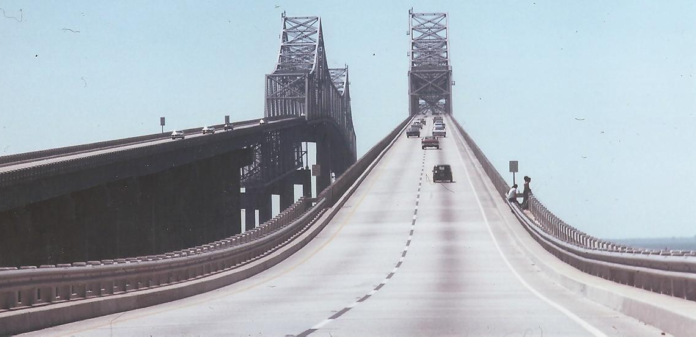On May 9, 1980, 35 people traveling southbound across the Sunshine Skyway Bridge died after plunging into Tampa Bay, unaware that the structure had partially collapsed after being struck by a ship only moments before. One man survived the incident after a 1,400-foot piece of concrete roadway fell 150 feet into the water along with eight vehicles, including a bus.
Leading Up to the Tragic Event
The weather that morning was treacherous—it was pouring rain, wind gusts hit speeds of 90 mph, and there was zero visibility. At 7:30 a.m., it was also rush hour.
Joe Blasewitz, a state transportation inspector, crossed the bridge shortly before the accident and later told AP: “It was phenomenal, unbelievable. The storm had been so ominous. It had blown through, and everything was overcast. I thought, ‘God is looking over me because I got across the bridge.’”
The ship that struck the bridge, the Summit Venture, was helmed by harbor pilot John Lerro. The blinding conditions incapacitated the ship’s 609-foot radar when it was seven-tenths of a mile from the bridge. There was also an approaching ship leaving the bay, and Lerro was concerned that the two ships may collide if he turned the Summit Venture out of the shipping channel. So, Lerro attempted to guide the vessel through the channel beneath the bridge. He failed. The ship hit a pier and compromised a bridge support, which collapsed and took out six cars, a pickup truck, and a bus with 26 people on board.
Lerro immediately contacted the Coast Guard after striking the bridge. According to the radio transcription (via the Tampa Bay Times) Lerro exclaimed: “Get emergency . . . all the emergency equipment out to the Skyway bridge. Vessel has just hit the Skyway bridge. The Skyway bridge is down! Get all emergency equipment out to the Skyway bridge. The Skyway bridge is down. This is Mayday. Emergency situation. (Nearly screaming) Stop the traffic on that Skyway bridge!”
WATCH: 38 years ago today, the Sunshine Skyway Bridge collapsed into Tampa Bay as it was hit by a cargo ship, sending a Greyhound bus and other vehicles plummeting 150 feet into the water.
More than 30 people were killed.
This was the @NBCNightlyNews report from that night. pic.twitter.com/vDc3TFY2HH
— NBC News (@NBCNews) May 9, 2018
The driver of the pickup truck, Wesley MacIntire, was the sole survivor of those who hit the water after crew members from the ship rescued him. Witness Anthony Gattus was traveling with three coworkers in a car when he saw the Greyhound bus disappear in front of him. He recalled: “The bus went by us and then, there was nothing, just darkness. We slid to a stop on the metal part of the bridge and got out.”
Gattus’ vehicle stopped just over one foot from the edge of the southbound lane as it hung over the bay. Gattus crawled on his hands and knees and hung on to the grate on the ground as he climbed to safety. He said, “We started going up the ramp of the bridge and I’m hollering to the others: ’The cars ain’t going to see us or hear us. We’re going to get run down.’”
Lywood Armstrong was one of the lucky ones—she got off the bus one stop before it crossed the bridge. However, she lost her friend, John “Chip” Callaway Jr., 19. “When I saw them pulling up the bodies and the bus later and saw the number on the side of the bus I knew that was the one I got off,” she told 10 Tampa Bay.
The Aftermath
The northbound section of the twin span bridge remained intact and proceeded to carry travelers across the bay until a new bridge was completed in 1987. The new bridge, the Bob Graham Sunshine Skyway bridge, named after the former governor and U.S. senator Bob Graham, is taller, so ships can more easily pass under. The bridge also features several dozen bumpers known as dolphin structures that protect it from impact.
However, for over a decade, the wreckage of the southbound span, complete with a huge hole in the midst of it, stood standing until it was demolished. The ends of the bridge were eventually converted into fishing piers.
It’s been 40 years since Tampa Bay experienced one of its worst tragedies – the collapse of the old Sunshine Skyway bridge.
Here are the historic photos captured on that day: https://t.co/ZlK2qkKCxI pic.twitter.com/JkXYQlDBw1
— Tampa Bay Times (@TB_Times) May 9, 2020
A man named Jim Crispin, one of Gattus’ colleagues who was in the vehicle with him, never traveled over the bridge again. His widow, Mary, said: “He couldn’t do it. There was too much realism—a busload of people drowned. ″
As for the ship pilot Lerro, the Coast Guard concluded in its investigation that his decision to sail in zero visibility was a contributing cause of the crash. It also determined that the oncoming tanker was anchored and therefore not a threat. In addition, the Coast Guard determined that the blinding storm was not predicted, and a passing pilot did not warn Lerro about the weather conditions. Lerro lost his license but earned it again before quitting the ship piloting business and launching a new career at a crisis hot line.
By Noelle Talmon, contributor for Ripleys.com
EXPLORE THE ODD IN PERSON!
Hits: 0









